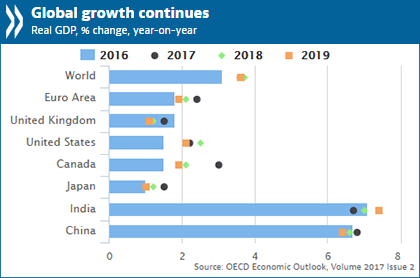OECD sees global economy strengthening, but says further policy action needed to catalyse the private sector for stronger and more inclusive growth
The world economy has strengthened, with monetary and fiscal stimulus underpinning a broad-based and synchronised improvement in growth rates across most countries, according to the OECD’s latest Economic Outlook.

Annual growth of the world economy is projected to improve slightly in 2018, but remains below the pre-crisis period and that of past recoveries. Longer-term challenges inhibit stronger, more inclusive, and more resilient economies.
The Outlook notes persistent effects of prolonged sub-par growth on private sector performance including investment, trade and productivity. Employment rates are now above pre-crisis rates in many OECD economies and unemployment is falling, but this has yet to produce solid real wage gains. In the absence of a clear sign of change in underlying trends, growth across the OECD is projected to weaken in 2019.
“Growth has picked up momentum and the short-term outlook is positive, but there are still clear weaknesses and vulnerabilities,” said OECD Secretary-General Angel Gurria. “There is a need to focus structural and fiscal action on boosting long-term potential as monetary policy support is reduced. Countries should implement reform packages that catalyse the private sector to promote productivity, higher wages and more inclusive growth.”
Household and corporate debt in many advanced and emerging market economies is high, creating vulnerabilities and raising questions about the sutainability of growth in the medium term. A special chapter in the Economic Outlook, on “Resilience in a Time of High Debt,” calls for an integrated policy approach, drawing not only on macroeconomic and macroprudential instruments but also tackling underlying structural issues.
A sounder and healthier financial system would reduce the tax bias towards debt, deepen equity markets and improve the design of insolvency regimes. Removing tax subsidies for housing and making housing supply more fluid would mitigate the tendency to boom-and-bust cycles.
The OECD projects that the global economy will grow by 3.6 percent this year, 3.7 percent in 2018 and 3.6 percent in 2019. The projections reflect slight improvements in the global economy since the previous Interim Economic Outlook in September 2017, but also concerns about long-term momentum.
In the United States, growth is estimated at 2.2 percent in 2017, rising to 2.5 percent in 2018, then dropping back to 2.1 percent in 2019.
The euro area is projected to grow at a 2.4 percent rate in 2017 and a 2.1 percent pace in 2018 – upward revisions from previous projections driven by stronger growth in key European countries – before slowing to a 1.9 percent pace in 2019.
Germany is forecast to grow by 2.5 percent in 2017, 2.3 percent in 2018, and 1.9 percent in 2019. France is projected to grow by 1.8 percent over the 2017-18 period and 1.7 percent in 2019, while Italy will see a 1.6 percent growth rate this year, a 1.5 percent rate in 2018 and a 1.3 percent rate in 2019. The revised projections reflect stronger-than-expected performance in the first half of 2017, in the context of rising employment, accommodative monetary policy and stronger consumption growth and investment.
In the United Kingdom, the growth slowdown is expected to continue through 2018, due to continuing uncertainty over the outcome of negotiations around the decision to leave the European Union and the impact of higher inflation on household purchasing power. In this context, the UK is projected to grow by 1.5 percent this year, 1.2 percent in 2018 and 1.1 percent in 2019.
Growth in Japan is projected at 1.5 percent for 2017, which is slightly below the forecast in the September 2017 Interim Economic Outlook, and to remain close to 1 percent in 2018 and 2019 as fiscal consolidation resumes and the decline in the working-age population accelerates.
The Canadian economy is bouncing back to 3 per cent growth rate this year, before slowing to 2.1 percent in 2018 and 1.9 percent in 2019 as policy stimulus is withdrawn.
Expansion in the major emerging market economies is improving, on the back of renewed infrastructure investment in China and recovery from recession in major commodity-exporting economies, but remains softer than in the past..
Growth in China is projected at 6.8 percent in 2017, 6.6 percent in 2018, and 6.4 percent in 2019, partly reflecting the ongoing rebalancing in China’s growth model.
In India, growth is projected at 6.7 percent in 2017 and 7.0 percent in 2018, before picking up to a 7.4 percent rate in 2019, thanks to reforms that are expected to boost investment, productivity and growth.
Russia is rebounding from recession, and is projected to grow by 1.9 percent in 2017 and 2018 and 1.5 percent in 2019. Brazil is also expected to exit recession, with a 0.7 percent growth rate in 2017, 1.9 percent in 2018 and 2.3 percent in 2019.
“The global economy is flying low and at risk of financial turbulence,” said OECD Chief Economist Catherine Mann. “The only strategy is to pursue an integrated policy approach that will balance actions to boost growth, mitigate risks in the financial sector and improve resilience. We cannot afford to be complacent and assume that today’s economy is as good as it gets – future generations have a right to ask for better.”
Source: Organisation for Economic Co-operation and Development
- 242 reads
Human Rights
Ringing FOWPAL’s Peace Bell for the World:Nobel Peace Prize Laureates’ Visions and Actions

Protecting the World’s Cultural Diversity for a Sustainable Future

The Peace Bell Resonates at the 27th Eurasian Economic Summit

Declaration of World Day of the Power of Hope Endorsed by People in 158 Nations

Puppet Show I International Friendship Day 2020

